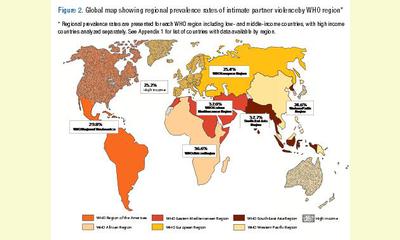|
|
WHO report highlights violence against women as a global health problem of epidemic proportions
un article par World Health Organization Media Centre (abridged)
Physical or sexual violence is a public health
problem that affects more than one third of all
women globally, according to a new report released
by WHO in partnership with the London School of
Hygiene & Tropical Medicine and the South African
Medical Research Council.

Global map showing regional prevalence rates of intimate partner violence. Rates are presented for each WHO region including low- and middle-income countries with high income countries analyzed separately.
click on photo to enlarge
The report, Global and regional estimates of
violence against women: Prevalence and health
effects of intimate partner violence and non-
partner sexual violence, represents the first
systematic study of global data on the prevalence
of violence against women – both by partners and
non-partners. Some 35% of all women will
experience either intimate partner or non-partner
violence. The study finds that intimate partner
violence is the most common type of violence
against women, affecting 30% of women worldwide.
The study highlights the need for all sectors to
engage in eliminating tolerance for violence
against women and better support for women who
experience it. New WHO guidelines, launched with
the report, aim to help countries improve their
health sector’s capacity to respond to violence
against women. . .
They also point out that some health-care
settings, such as antenatal services and HIV
testing, may provide opportunities to support
survivors of violence, provided certain minimum
requirements are met.
* Health providers have been trained how to
ask about violence.
* Standard operating procedures are in place.
* Consultation takes place in a private
setting.
* Confidentiality is guaranteed.
* A referral system is in place to ensure that
women can access related services.
* In the case of sexual assault, health care
settings must be equipped to provide the
comprehensive response women need – to address
both physical and mental health consequences.
The report’s authors stress the importance of using
these guidelines to incorporate issues of violence
into the medical and nursing curricula as well as
during in-service training.
WHO will begin to work with countries in South-
East Asia to implement the new recommendations at
the end of June. The Organization will partner
with ministries of health, non-governmental
organizations (NGOs) and sister United Nations
agencies to disseminate the guidelines, and
support their adaptation and use. . .
The report was developed by WHO, the London School
of Hygiene & Tropical Medicine and the South
African Medical Research Council. It is the first
systematic review and synthesis of the body of
scientific data on the prevalence of two forms of
violence against women – violence by an intimate
partner and sexual violence by someone other than
an intimate partner. It shows for the first time,
aggregated global and regional prevalence
estimates of these two forms of violence,
generated using population data from all over the
world that have been compiled in a systematic way.
The report documents the effects of violence on
women’s physical, mental, sexual and reproductive
health. This was based on systematic reviews
looking at data on the association between the
different forms of violence considered and
specific health outcomes.
[Note: Thank you to Janet Hudgins, the CPNN reporter
for this article.]
( Click here for the French version or here for a version in Spanish.)
|








|
DISCUSSION
Question(s) liée(s) à cet article:
Protecting women and girls against violence, Is progress being made?
* * * * *
Commentaire le plus récent:
The 47 CPNN articles devoted to this theme suggest that indeed progress is being made.

|
|









